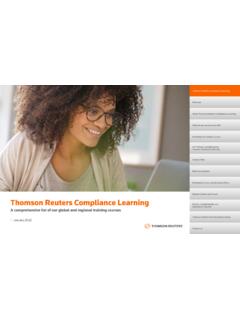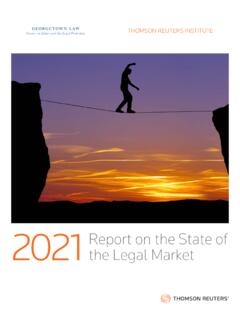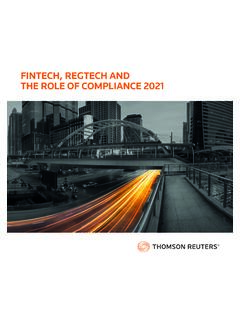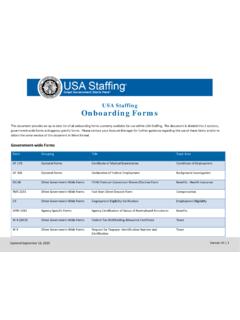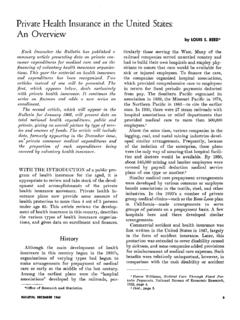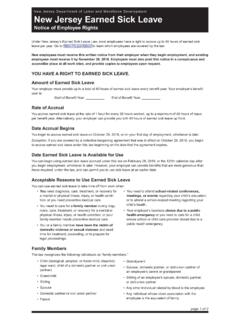Transcription of Paid Sick Leave State and Local Laws Chart: Overview
1 2021 Thomson Reuters. All rights reserved. Use of Practical Law websites and services is subject to the Terms of Use ( ) and Privacy Policy ( ). PRACTICE NOTEPaid Sick Leave State and Local Laws Chart: Overviewby Practical Law Labor & EmploymentStatus: Maintained | Jurisdiction: Alabama, Arizona, Arkansas, California, Colorado, Connecticut, District of Columbia, Florida, Georgia, Illinois, Indiana, Iowa, Kansas, Louisiana, Maine, Maryland, Massachusetts, Michigan, Minnesota, Mississippi, Missouri, Nevada, New jersey , New York, North Carolina, Ohio, Oklahoma, Oregon, Pennsylvania, Puerto Rico, Rhode Island, South Carolina, Tennessee, Texas, USA (National/Federal), Vermont, Washington, WisconsinThis document is published by Practical Law and can be found at: Request a free trial and demonstration at.
2 Of Paid Sick Leave LawsMost workers require some time off each year to care for their own and their family members health and medical needs. Until recently, no federal law mandated that private US employers provide paid sick Leave for their employees. (For information about President Obama s executive order mandating paid sick Leave for federal contractors, see Paid Sick Leave for Federal Contractors.) However, emergency legislation enacted in response to the 2019 novel coronavirus (COVID-19) outbreak guarantees paid sick Leave to certain private employees for specified purposes related to coronavirus (see Federal Emergency Paid Sick Leave Act in Response to Coronavirus).Most private employees traditionally had to rely on policies voluntarily implemented by their employers to receive any paid sick Leave .
3 To fill this gap in coverage, some states and municipalities have passed laws requiring certain employers to provide paid sick Leave (PSL) to their employees. More than 15 states, plus the District of Columbia and the Commonwealth of Puerto Rico, have now passed statewide paid sick Leave laws. Two of these State laws (Maine and Nevada) allow paid Leave to be taken for any reason, not only for sick Leave . More than 30 Local jurisdictions have passed paid sick Leave laws across the country applicable to private employers (though some have been preempted by later-enacted statewide laws).Momentum toward enacting these laws continues, creating challenges for multi-jurisdictional employers that must provide their workers with sufficient paid Leave to comply with multiple State or Local laws.
4 Some states have passed their own measures or clarified existing law to ensure coverage for absences related to COVID-19. Although some employers can implement a single policy for all employees that complies with the most generous of any applicable laws, as more laws are passed, it will become increasingly difficult for employers to create uniform policies for their workers. For a sample general paid time off (PTO) policy, see Standard Document, Paid Time Off/Vacation help employers stay abreast of and comply with the rapidly changing legal developments in this area, the following charts, organized by State and frequently updated, provide an Overview of the laws mandating paid sick Leave for private-sector employees in some form, citing the legal source and common issues addressed by each law.
5 Although the laws vary in detail, the laws typically address:At-a-glance charts summarizing private employers obligations under State and Local law to provide paid sick Leave or unspecified paid Leave that can be used for any reason including sickness to their employees. This resource covers requirements in those states, counties, and municipalities that have enacted paid Leave laws and is organized by State . It also summarizes key provisions of the laws and ordinances, including employee eligibility, employer coverage, Leave accrual and usage, carryover and payout, notice and posting requirements, and penalties for noncompliance. This resource also covers the federal Emergency Paid Sick Leave Law enacted as part of Coronavirus Families First Act, and generally identifies those jurisdictions that have enacted other COVID-19 related measures.
6 For more up-to-date State COVID-19 developments, see COVID-19: Employment Law and Development Tracker. This resource covers private, non-unionized employers. For more information on State Leave laws generally, see the Leave Laws: State Q&A Tool and State employee Leave Practical Law 2021 Thomson Reuters. All rights reserved. Use of Practical Law websites and services is subject to the Terms of Use ( ) and Privacy Policy ( ). Paid Sick Leave State and Local Laws Chart: Overview Covered employers. Some laws mandate paid sick Leave only for employers of a certain size or delineate Leave provisions based on the size of the employers. Many laws contain exclusions for government employees or employees in certain industries covered by a collective bargaining agreement (CBA).
7 Although beyond the scope of this chart, some municipalities have enacted laws or policies mandating paid sick Leave for their own public sector employees. Covered employees. Some laws require employees to work a certain number of hours within the covered jurisdiction or be employed for a minimum time period before becoming eligible for paid Leave . Other laws exclude certain categories of workers, such as nonexempt employees, independent contractors, and work-study program participants. Leave accrual and usage. Paid sick Leave laws generally specify how much Leave employees accrue and when they accrue it, when employees can use accrued Leave , and whether employers can frontload Leave entitlement in lieu of accruals based on hours worked. Many laws allow employers to cap annual Leave accrual, and some vary these caps based on employer size.
8 Many laws also require employees to work for a minimum time period before they can use Leave . Carryover of unused sick Leave . Many laws require employers to carry over accrued unused sick Leave , often with an annual cap. Some laws restrict further accruals until some portion of the sick Leave is used. Others allow or require employers to pay for unused Leave annually or frontload annual Leave entitlements in lieu of carryover requirements. Definition of family member. The definition of family member varies significantly, but most jurisdictions expressly recognize the step, foster, and adopted parent-child relationship to the same degree as blood relatives. Where covered child relationships are defined (such as step, foster, and guardianship relationships), the converse parental relationships are also covered, unless otherwise specified.
9 Some jurisdictions specifically cover legal spouses and civil union or domestic partners. Other jurisdictions simply afford protections to spouses. In light of the US Supreme Court s decision in Obergefell v. Hodges, 135 S. Ct. 2584 (2015), which held that same-sex couples have the right to marry in all states and a State may not refuse to recognize a lawful same-sex marriage performed in another State based on its same-sex character, any Leave law that allows Leave for the care of an employee s spouse or child of an employee s spouse likely includes all legally-married spouses, whether of the same or different sex (see Legal Update, Supreme Court s Recognition of Same-Sex Marriage Raises benefits and Employment Law Issues). Qualifying use of Leave . Most paid Leave laws allow Leave to be used for more than an employee s own illness, such as for preventive medical care or medical care (including preventive care) for a family member.
10 Some jurisdictions also allow employees to use Leave for reasons related to domestic violence, stalking, abuse, or human trafficking (commonly referred to as safe Leave ), or necessitated by a public health emergency at a school or workplace. For example, Westchester County has enacted a law requiring paid safe Leave in addition to paid sick Leave . Some jurisdictions now mandate paid Leave that may be taken for any reason, such as Maine and Nevada. Interaction with existing sick Leave plans. Most paid Leave laws provide that employers that already offer paid sick Leave at least as generous as the Leave required by law do not need to offer additional Leave to their employees. Notice, posting, and recordkeeping requirements. Most laws require some combination of workplace posting and individual notice to employees.
